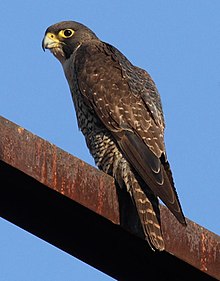

photo by Christopher Watson
http://www.comebirdwatching.blogspot.com/?view=classic
Peregrine Falcon (Falco peregrinus)
PBS's NOVA recently had a great piece on peregrine falcons.
Many know this predator as the fastest animal on the planet (200 mph in a dive), and some may know that it was almost driven to extinction in the U.S. by the use of the pesticde DDT, but recovered (with intense effort by conservationists) after DDT was banned in this country in 1972. And some may know that it preys on other birds. Finally, some may know that this species has adapted to life in cites, with the skyscapers being nesting spots similar to the cliffs it uses to nest in the wild, and with pigeons and other common city birds used for prey.
But perhaps most did not knnow that peregrines have a world-wide
distribution, being absent only in Antarctica.
An amazing quality of this bird of prey, elucidated by research depicted on the
NOVA program, is that it can spot a prey object about the size of a tennis ball
from 3 km (almost 2 miles) away.
Portia spp. a n Old World spider with remarkable cognitive ability
 photo by Donald Hobern [ here resized]
https://www.flickr.com/photos/25401497@N02/15857541765
photo by Donald Hobern [ here resized]
https://www.flickr.com/photos/25401497@N02/15857541765
In case you missed the BBC program The Hunt, narrated by David
Attenborough, this tiny spider (< 1 cm) with a brain
smaller than the head of a pin shows problem-solving ability
usually only seen in mammals. Portia is a jumping spider (Family
Salticidae) and they stalk prey rather than build a web. Portia
displays the ability to apprehend its prey(other spiders)
in novel situations and to recall what strategy works.
See this link for more information and other links regarding this
amazing creature:
But no words can do justice to the incredible cinematography in the BBC program, "The Hunt". It is even more remarkable when you consider that this spider is only 5-7mm in size.